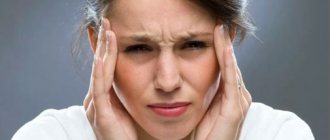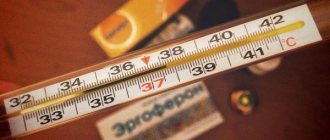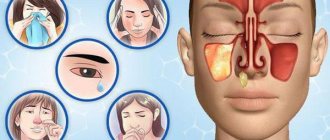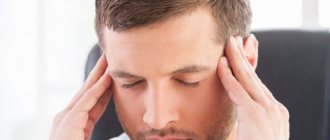Diagnosis of cranialgia
To prevent a part of the head from shooting through acute pain, it is necessary to accurately determine the reasons for its occurrence.
To do this, you often have to undergo an extensive examination. After being examined by a therapist and passing the necessary tests, the patient is referred to specialists:
- The ENT doctor will check the hearing organs and examine the nasal cavity to rule out infectious diseases;
- a vertebrologist will check the condition of the spine to exclude cervical osteochondrosis;
- A neurologist performs brain diagnostics to exclude dangerous pathologies and inflammatory processes.
If one of these diseases is detected, a thorough examination of the head and cervical spine is prescribed: MRI, X-ray, ultrasound.
Safe modern medicines and pills
When planning a visit to the doctor, the patient should be prepared to answer questions about how often pain occurs and what its intensity is. This will help the doctor develop the correct treatment tactics.
Groups of drugs effective for episodic attacks of pain
The main medications for the treatment of this pathology are nonsteroidal anti-inflammatory drugs (NSAIDs). They not only have an analgesic effect, but also relieve inflammation and eliminate swelling.
Most often prescribed:
- Ibuprofen—400 mg per day;
- Ketoprofen—100 mg/s;
- Naproxen—500 mg/s;
- Meloxicam—7.5-15 mg/s;
- Celecoxib—200 mg/s.
Most NSAIDs have a very negative side effect: with long-term use, they negatively affect the gastrointestinal tract, even leading to the development of drug-induced gastritis.
Medicines Meloxicam and Celecoxib are new generation drugs that do not have a negative effect on the gastrointestinal tract. The disadvantages of using these drugs include the relatively high price.
Analgesics are most often used at home to relieve an attack. They do not treat the disease, but only relieve pain. Drugs in this group are suitable for stopping episodic attacks, but their systematic use can lead to the occurrence of abuse syndrome.
During an attack of pain, you can take Paracetamol - 100 mg, Citramon, Analgin - 500 mg or Mig 200-400 mg.
If the examination revealed the appearance of cephalgia after exercise as a result of increased blood pressure, the doctor will prescribe medications prescribed at an early stage of the development of hypertension. These include: vasodilators, ACE inhibitors, diuretics, calcium channel blockers.
Remember! Self-prescribing antihypertensive drugs is unacceptable. Self-medication can lead to serious consequences.
For muscle tension, drugs from the group of muscle relaxants are used as part of complex therapy. They relax the spasmodic muscles of the head and neck, relieving pain of a spastic nature, and help restore blood flow.
Most often prescribed:
- Mydocalm—150-450 mg per day;
- Sirdalud (Tizanidine)—4 mg/s;
- Baclofen—15 mg/s.
Nootropic drugs are often prescribed as part of complex therapy: Phenibut, Nootropil, Glycine. Nootropics have an activating effect on brain function and increase its resistance to damaging factors. The drugs improve cerebral circulation and eliminate the consequences of traumatic brain injuries.
Sedatives in combination with basic drugs lead to muscle relaxation and decreased vascular tone. Taking tranquilizers helps relieve pain, but this type of medication very quickly causes drug dependence with withdrawal symptoms.
Sedatives that are not addictive: Afobazol, Atarax; alcohol tinctures of valerian, motherwort, Maryina root.
For severe attacks, a combination of drugs is used: Sirdalud 2 mg + Aspirin 500 mg or Analgin 250 mg + sedative.
The use of vitamin B complexes has proven itself. Vitamins B1, B6, B12 have a beneficial effect on the central nervous system and restore the structure of nerve tissue. Vitamin complexes are usually prescribed: Neuromultivit, Milgamma, Neurovitan.
If attacks of pain recur more than ten times a month, a course of treatment with Ibuprofen at a dose of 400 mg per day for 2-3 weeks and treatment with muscle relaxants is prescribed for 2-4 weeks.
There is no single scheme for pain relief. Depending on the cause, an individual selection of medications is recommended for each patient.
Treatment of chronic disease
Sometimes cephalalgia becomes chronic. The pain occurs every day, almost continuously, with varying degrees of intensity.
In this case, tricyclic antidepressants are prescribed for a long course of 2-6 months. They not only relieve pain, but also help normalize the psycho-vegetative state of the nervous system.
Most often, Amitriptyline is prescribed 10-100 mg/s, the dose is increased gradually. The drug relieves pain well, but has many negative side effects and is addictive.
As an alternative, selective serotonin reuptake inhibitors are prescribed: Fluoxetine, Paroxetine, Sertraline. The course of treatment is at least two months. These drugs have less toxicity.
In addition to prescribing drug therapy, the doctor will definitely recommend a massage, a course of physiotherapy or acupuncture.
Treatment
To get rid of conditions associated with throbbing pain, appropriate treatment is carried out taking into account the causes of the headache. If a tumor is present, radiation therapy, chemotherapy or surgery are prescribed depending on the patient’s condition and indications.
From the editor: Structure and functions of brain neurons
Treatment of abusus cephalgia begins with the withdrawal of the painkiller that provoked its appearance. Along with drug therapy, psychotherapy is carried out - the correction of depressive disorders, which often develop in patients who tend to uncontrollably take large amounts of medications. To relieve a migraine attack, a combination of Paracetamol and Aspirin is usually used.
Drugs such as triptans and Ergotamine will help get rid of throbbing and painful sensations in the head during migraine. At the same time, medications are prescribed to eliminate the accompanying symptoms. Treatment of post-traumatic cephalgia, which occurs in a chronic form, involves the prescription of antidepressants and the implementation of preventive measures aimed at preventing the development of abusive pain.
Drug therapy includes the prescription of Amitriptyline (tricyclic antidepressant), Propranolol (non-selective beta-blocker), Sodium Valproate (anti-epileptic, anti-migraine effect), Verapamil (calcium channel blocker). In parallel, procedures are shown - acupuncture, transcranial magnetic stimulation, electrical neurostimulation, massage.
Treatment of diseases of the bone structures (arthrosis, spondylosis, osteochondrosis) of the spine includes drug therapy (muscle relaxants, non-steroidal anti-inflammatory drugs), physiotherapy (electrophoresis, ultraphonophoresis), manual therapy, therapeutic exercises and massage. In some cases, wearing orthopedic structures that hold the spine in the correct position is indicated.
When there is a pulsating pounding in the ears
It is very important to record the time and circumstances under which tinnitus and pulsation occur. If this occurs during overheating, after active physical activity and gradually subsides within 10 to 15 minutes, then you should not worry too much.
If the pulsating pounding in the ear does not go away on its own within a few hours, then you should consult a doctor as soon as possible. This may be a symptom of a developing cerebral stroke. But most often, constant knocking in the ear is a symptom of a violation of the movement of blood through the posterior vertebral arteries. This pathology develops in every second patient suffering from cervical osteochondrosis. Already at the second stage of this disease, when protrusion of at least one intervertebral disc occurs, the course of the vascular bed changes sharply due to deformation of the uncovertebral canal.
The pounding of the pulse in the ear on one side indicates that only this posterior vertebral artery is affected. The sound of heartbeats in the ears on both sides indicates a bilateral pathology.
A diagnostic examination is necessary. It includes ultrasonography (USDG), a study of the patency of cerebral blood vessels. Using ultrasound, you can diagnose the posterior vertebral artery, atherosclerosis, etc.
It is also recommended to take an x-ray of the cervical spine. With its help, you can eliminate deformation of the vertebral bodies and the joints located between them. To diagnose protrusion and intervertebral hernia, it is better to conduct an MRI examination. It allows you to visualize the condition of all soft tissues of the spinal column.
What causes the feeling of pulsation in the head?
Why does my head throb? A pounding in the head without pain can occur due to various situations and reasons.
Pulsation in the head - the causes of its occurrence are the following:
- Problems with blood vessels in the head.
- Hypertonic disease. In this case, normal blood flow is prevented by narrowing of the blood vessels in the brain. The greater the pressure, the stronger the pulsation will be felt.
- Cervical osteochondrosis. Patients with this diagnosis often experience pulsation in the occipital or crown area. The reason is an increase in vertebral tissue, which puts pressure on the vertebral artery, which provokes poor circulation and the appearance of pulsation.
- Oncological processes. As a rule, formations can be the basis for the occurrence of pulsation in the head without pain. Mostly pulsation appears in the morning. The appearance of pulsating sensations is associated with compression of the blood vessels by the tumor. As the tumor grows, the attacks of pulsation become more intense, which causes pain. Soon, other symptoms will appear that will indicate the presence of a tumor in the brain.
- Atherosclerosis of the vessels of the head and neck. At the first stage of atherosclerosis, pulsating sensations in the head may be observed, manifesting without pain. The reason is the appearance of atherosclerotic plaques in the arteries of the brain, which are the reason that interferes with free blood circulation.
- Glaucoma. A rather complex disease that affects the organs of vision and is accompanied by the appearance of pulsation in the forehead as intraocular pressure increases.
- Constant stressful situations, emotional stress and worries can increase intense blood circulation through the vessels. At such moments of intense stress, as a result of the increased content of adrenaline, a spasm of the arteries and veins occurs. This in turn obstructs blood flow, causing a pulsating sensation.
In addition, pulsation in the head without pain can occur once, briefly and for a short time. As a rule, the causes of such headaches are:
- Bad habits: smoking and drinking alcohol
- Drinking coffee drinks
- Taking drugs and energy drinks
- Psycho-emotional arousal
- Staying in an awkward position or body position for a long time
- Incorrect body position during sleep
In such situations, pulsation, as a rule, quickly passes on its own and does not appear again. In case of recurrence of attacks, increase in their intensity and duration, it is necessary to consult a doctor and undergo further examination. The doctor should first of all find out the following information:
- Location of pain
- At what period of the day does it occur?
- Frequency of occurrence
- Presence of provoking factors
- Presence of chronic diseases
Diagnosis of the causes of pulsation
It is very important to see a doctor if these symptoms appear. After all, pulsation in the head can be a sign of serious diseases, for example, aneurysm, atherosclerosis or hypertension. Therefore, timely diagnosis will help avoid complications. When contacting a doctor, it is important to talk in more detail about your sensations: when and how often the pulsation occurs, where it is localized, what factors provoke it, whether there is pain. Typically, after collecting this information, the doctor prescribes the following diagnostic procedures:
- blood and urine tests;
- MRI or ultrasound of the brain;
- electroencephalogram;
- angiography;
- X-ray of the cervical spine.
A consultation with a neurologist, ophthalmologist, cardiologist, otolaryngologist, and neurosurgeon will also be necessary.
Diseases accompanied by heaviness in the head
With a heavy head, the causes are varied. Sometimes we are talking about serious disorders, ignoring which is fraught with adverse consequences.
VSD
A heavy head with VSD is one of the first manifestations of the disease. Somatoform autonomic dysfunction (vegetative-vascular dystonia) characterizes a set of disorders that are close to organic diseases due to physical symptoms, but do not have organic causes. Manifestations include lethargy, heaviness in the head and drowsiness.
Meniere's disease
This is a chronic disease with typical symptoms.
Main symptoms of the disease:
- hearing impairment;
- heaviness in the head;
- ear pressure;
- tinnitus;
- dizziness when walking and moving the head.
Osteochondrosis
With cervical osteochondrosis, there is a headache and pain in the neck. This is often caused by prolonged incorrect or overstrain of the spine.
Neurosis-like conditions
Problems associated with neuroses manifest themselves as functional mental disorders that impair the ability to adapt to life situations.
Neuroses are accompanied by sleep disturbances, headaches on the left side of the head or on the right, muscle, and spinal pain.
Editorial: Effective head massage techniques
Neoplasms
A heavy head is the most common symptom associated with an intracranial tumor. This is the first symptom of a potential threat. Because the brain is so fragile, it is “packed” in the skull as safely and tightly as possible, leaving no room for expansion. Therefore, an enlarged tumor causes severe headaches.
Injury
PTSD occurs after moderate to severe trauma. In most cases, it manifests itself with headaches, balance problems, memory disorders, and depression for a period of 6 months to 3 years.
Circulatory disorders
The main cause of heaviness in the head due to poor circulation is a vascular disorder caused by dysfunction of the nervous system. When the blood vessels narrow or dilate, the blood supply to the brain is disrupted, resulting in heaviness in the head area.
Sinusitis, mastoiditis, frontal sinusitis
With mastoiditis, the ears become blocked, heaviness comes from the ear area, and the neck often hurts.
Inflammation of the sinuses and frontal cavities can be a complication of rhinitis. Heaviness and pain in the head worsens when bending down. The worst condition is in the morning. A typical symptom is heaviness in the eyes.
Tensor headaches
The primary triggers for this type of headache are stress, mental tension, and depression. The pain is pressing (head heavy, aching) or expansive (not throbbing). The intensity is mild or moderate and only partially limits usual activities.
Alcohol intoxication
The fact that after drinking alcohol you get a headache and put pressure on your eyes does not surprise anyone. But the result of a stormy party is a long-term, heavy, cloudy head.
Blood pressure problems
For many people, frequent headaches are caused by hypertension. High blood pressure increases the pressure inside the head, causing chronic heaviness.
Other diseases
Heaviness in the head and nausea may occur due to other diseases of the head or neck:
- trigeminal neuralgia;
- SUNCT syndrome;
- mandibular dysfunction;
- myalgia;
- eye diseases;
- dental diseases.
Associated symptoms depending on the cause
Throbbing and aching in the head can be accompanied by various symptoms and characteristic signs, which in most cases will depend on the provoking cause:
- with migraine, the head pulse occurs directly on one side of the head, this condition is necessarily accompanied by severe pain, nausea, increased sensitivity to various irritants, weakness and dizziness;
- in atherosclerosis it is accompanied by pain, which becomes dull and pressing as the disease progresses;
- for colds and inflammatory diseases is accompanied by corresponding symptoms;
- with glaucoma, the pulse in the head is accompanied by impaired visual function and pain;
- with tumors , the patient in the morning experiences not only intense pulsation in the head, but also nausea, vomiting, drowsiness and unreasonable fatigue;
- for diseases of the oral cavity, this condition is considered a concomitant symptom and is accompanied by other signs of pathologies;
- with osteochondrosis of the cervical spine, the patient simultaneously experiences pain in this area of the spine, tinnitus, darkening of the eyes and loss of coordination;
- with cervical migraine, the patient also experiences pain in the occipital region on one side and impaired perception.
Migraine is a factor that provokes noise, pulse and pain in the head:
Main and secondary reasons
The reasons that contribute to the occurrence of pulsation syndrome and pain in the head, as a rule, are related to a specific pathology.
Among the most common such pathologies are the development of the following:
- Hypertension.
- VSD.
- Osteochondrosis of the neck.
- Vascular pathologies.
- Diseases of ENT organs.
- Pathologies of the visual system.
- Psychological or mental disorder.
High blood pressure (hypertension)
The feeling of pulsation and noise in the head is one of the signs of hypertension, characterized by high blood pressure.
There is a narrowing of blood vessels and poor circulation, which causes a characteristic syndrome in the head and ears.
Severely increased pressure causes headaches in the occipital region.
Vegetative-vascular dystonia
The disease is caused by a violation of the regulation of vascular tone in the central nervous system. With dystonia, the level of pressure changes (an increase is observed), spastic syndrome in the vessels.
The discrepancy between the flow and flow of blood from the brain is the source of an unpleasant sensation in the head area. The disease has a primary or secondary etiology.
Osteochondrosis
The disease is accompanied by a number of unpleasant symptoms that occur both in the affected area and in other areas - the head, ears, etc.
There is a decrease in the intervertebral distance, compression of the vessels that are responsible for the flow of blood to the head. If the latter process is disrupted, characteristic pulsation and pain occur.
Vascular diseases
In atherosclerosis, the lesion involves the internal arterial wall, which, narrowing, forms an atherosclerotic plaque in its space.
If a narrowing of more than 50% occurs, this contributes to insufficient blood flow into the vessels of the brain and characteristic symptoms.
Inflammation in the arteries of the head is called arteritis. Occurs against the background of injury or surgery. Less commonly, it has an autoimmune etiology.
The acute course of the pathology is characterized by severe throbbing pain in the head and general weakness.
Aneurysm of a vessel occurs with protrusion of its wall and its severe depletion
It is important to avoid pressure changes and head trauma to prevent cerebral rupture and bleeding
A small aneurysm occurs with the only manifestation – throbbing pain in the head.
Diseases of the ENT organs
Pulsation in the ears and head is a clinical manifestation that indicates the presence of a foreign object (for example, wax plug) in the ear canal.
Among the diseases that cause pulsation are various inflammatory processes: otitis media, eustachitis, sinusitis, sinusitis, etc.
Visual impairment
Not many people know that pathologies of the visual system can also cause noise, pulsating manifestations, and pain.
Incorrectly chosen glasses or lenses, for example, contribute to eye and brain overstrain.
The latter, present on a constant basis, in combination with mental work, becomes a source of unpleasant sensation.
Presence of a psychological or mental disorder
Systematic stress, nervous overstrain, lack of sleep, supplemented by poor nutrition and inadequate rest, increase the risk of exhaustion of the nervous system and the development of related diseases.
From the editor: Features of hemorrhagic stroke
Neurasthenia is one of them, which is characterized by the following symptoms:
- increased fatigue;
- violation of the work and rest regime;
- increased irritability;
- impaired concentration and memory;
- pressing headaches;
- pulsation and noise in the head and ears.
The clinical manifestation often occurs in schizophrenia.
Causes of throbbing pain in the back of the head
The feeling that the back of the head is throbbing from a headache indicates damage to the nerves or blood vessels, their inflammation or mechanical compression. Based on the intensity and nature of the painful sensations, we can tentatively assume their cause:
- acute, throbbing pain in the back of the head, which spreads to the entire surface of the head - infectious diseases, including influenza, meningitis, encephalitis;
- sharp pain in the form of repeated attacks is a manifestation of cervical migraine;
- unilateral or symmetrical pain in the back of the head, which causes numbness in the hands - damage to the occipital nerve;
- dull, aching pain – ischemia, insufficient blood supply to the occipital region.
If throbbing pain in the back of the head is accompanied by numbness in the hands, impaired hearing, vision or speech, or coordination of movements, it is important to exclude the possibility of a stroke. You should consult a doctor within the first 2 hours after an attack - it is during this period that medical care is most effective.
Vascular diseases
Pulsation in the back of the head is one of the manifestations of acute and chronic diseases of the vascular system. Important arteries that carry blood to the brain may be compressed from the outside or blocked from the inside. These processes, as well as infectious diseases, are accompanied by inflammation, pain, and insufficient blood supply to certain areas. These include:
- atherosclerosis is a chronic metabolic pathology in which the products of fat metabolism are deposited on the inner wall of the arteries and cholesterol plaques are formed;
- vasculitis - inflammation of blood vessels caused by injuries, compression of arteries or veins, as well as infectious processes;
- Vascular dystonia is a complex disorder that is accompanied by frequent surges in pressure and insufficient blood supply to the head and lower extremities.
For various vascular diseases, it is important to restore normal blood flow in the head, neck and back of the head. For this, medications, exercises, and physiotherapy sessions are prescribed. If acute or chronic vascular diseases are suspected, an ultrasound examination with a contrast agent is performed.
Diseases of the cervical spine
Throbbing pain in the back of the head can be a sign of acute or chronic neck diseases. They cause compression or spasm of the vertebral artery, which is important for cerebral circulation. As a result, the patient experiences acute, throbbing pain in the back of the head, dizziness, nausea, hearing and vision impairment. Symptoms disappear after a course of treatment, which eliminates the underlying cause of the pain.
As a result of diagnostics, the following violations may be detected:
- osteochondrosis is a chronic disease of the joints of the spine, which leads to thinning of the cartilage discs and deformation of the vertebrae;
- displacements and subluxations of the vertebrae - a violation of the anatomically correct placement of segments of the spinal column, which causes compression of the vessels and roots of the spinal nerves;
- protrusion of intervertebral discs - protrusion of cartilage in any direction, which is accompanied by acute pain in the neck and back of the head, as well as limited mobility;
- spondylosis is the fusion of two or more adjacent vertebrae as a result of trauma, surgery, or chronic deforming processes.
Cervical migraine is a disease that often progresses. It can worsen when weather or climate conditions change, or due to stress or physical exertion. The condition can be normalized with painkillers and antispasmodics, and the doctor can also prescribe muscle relaxants.
High blood pressure
Hypertension is considered a disease of older people, but in reality it can occur at any age. Increased stress, weakness of the vascular walls, excess weight and poor diet, as well as cardiac dysfunction are the main causes of this disease. Hypertension is considered to be an increase in blood pressure to levels greater than 120∕80 mm. rt. Art.
High blood pressure can be identified by the following symptoms:
- throbbing pain in the head, in the occipital region;
- dizziness, with a sharp increase in pressure, fainting is possible;
- redness of the facial skin, burning sensation, tingling, numbness;
- deterioration of hearing and vision, the appearance of dark circles before the eyes.
Doctors at the Clinical Institute of the Brain recommend having a tonometer in your home medicine cabinet, even if you have not previously experienced problems with high or low blood pressure. It is important to know your own normal indicators in order to notice the onset of an attack in time. They should be measured at rest - after physical activity and stress, pressure normally increases.
Neuralgia
Throbbing pain in the back of the head is one of the first signs of occipital neuralgia. It originates from the second cervical vertebra, passes through the muscles of the neck, under the base of the skull and goes to the scalp. Neuralgia refers to painful sensations that occur due to inflammation or mechanical compression of a nerve. The pain is acute, throbbing, lasts from several hours to several days, disappears after taking analgesics. Its causes may be:
- cervical spine injuries are the most common cause;
- degenerative diseases of the first two cervical vertebrae;
- arthritis – inflammatory diseases of the joints;
- neoplasms that compress the nerve.
Occipital neuralgia can occur in the absence of any congenital anomalies or chronic diseases. Its development is facilitated by incorrect posture, prolonged sitting, stress and other factors. One common cause is a spasm of the neck muscles, in which the nerve is compressed as it passes through this area.
Other reasons
If pain in the back of the head throbs frequently, this should be a reason for a full examination. During diagnosis, various disorders may be detected that require timely treatment:
- neoplasms located in the back of the head;
- diseases of the muscles of the back of the neck;
- increased intracranial pressure;
- migraine.
Headache is not the only symptom that indicates diseases of the heart and blood vessels, nervous system, neck and spine. It may be accompanied by nausea, deterioration of memory and attention, numbness of the hands and fingers, and sleep disorders.
The main causes of cephalalgia
Acute pain in the head and throbbing prevents a person from living a normal life and doing business. If pain appears once, this does not necessarily indicate the presence of dysfunction in the body. In cases where a person experiences cephalalgia more and more often, and the pain lasts longer and longer, there really is a problem in the body. It needs to be eliminated, and only a specialist can handle it.
Doctors identify a number of main reasons that cause this symptom, namely:
- VSD (vegetative-vascular dystonia);
- atherosclerosis;
- sinusitis, sinusitis;
- migraine;
- eye diseases;
- hematomas;
- tumors;
- neuralgia;
- stress.
Vegetovascular dystonia
Pulsating pain is called background pain. It occurs due to a decrease in the tone of cerebral vessels, stagnation of blood, and spasms of the arteries. The difference between pain that appears due to VSD is that “jolts” do not depend on the person’s pulse.
Atherosclerosis
If a patient has problems with the vascular system, he begins to suffer from pulsation in the temporal and occipital areas of the head. But the zones can change, and the sensations can become oppressive over time.
Sinusitis, sinusitis
The reason lies in the cold you suffered, namely its complications. In order not to encounter cephalalgia, it is imperative to cure all viral and infectious diseases. The same applies to a runny nose.
Migraine
Migraine is manifested by a pulsation, which patients describe as if it were pounding right under the skin, and the pain is localized in one part of the head at the top.
Scientists have not yet proven the definitive causes of such pain, and the exact forms of manifestation of the disease have not yet been determined.
But still, there are several possible causes of migraine development, namely:
- food products (several types of cheeses and sausages);
- weather sensitivity;
- smells of ammonia, ammonia, perfume;
- serious physical activity;
- emotional outburst;
- uncomfortable body position for a long time.
A migraine can torment a person for more than one day. There are cases when the pain lasts 3 days. Most often, cephalalgia caused by this problem manifests itself in unbearably severe pain, and can go away after a few hours. Doctors note the fact that females suffer more from this.
At the end of a migraine attack, a person notes that he has severe weakness and a tendency to sleep.
Eye diseases
The following reasons that can provoke pulsation are eye diseases. A large number of people turn to specialists with complaints such as blurred vision, nausea, dizziness, photophobia, and acute pain radiating to the eye. A competent doctor will immediately determine that these are symptoms of angle-closure glaucoma - high intraocular pressure.
Cephalgia can develop due to tension in the optic nerve, which occurs due to incorrectly selected diopters of glasses or lenses. But in such cases, dizziness also appears.
Hematomas, tumors
Pulsating pain of a strong nature, which is clearly localized in one of the areas of the head, may indicate the presence of damage or a neoplasm. Also in this case, it is worth noting the presence of nausea and vomiting.
If such symptoms are noticed, you must quickly contact a specialist to diagnose a tumor or other problem and begin to treat it.
Stress
All overwork and emotional turmoil can result in severe headaches. Constant nervous tension and stress can create a “fellow traveler” for you for the whole day, namely cephalgia.
Neuralgia
Another common reason why such unpleasant sensations occur in the temple and head area. Dental problems, trigeminal neuralgia - all this provokes pain.








